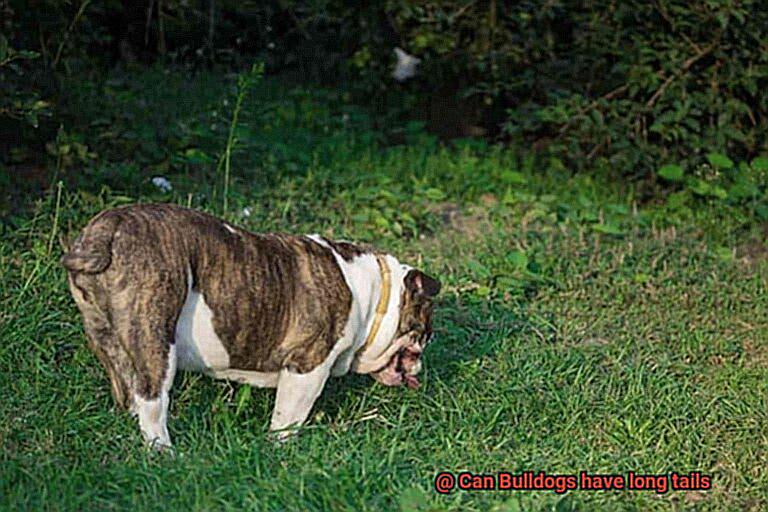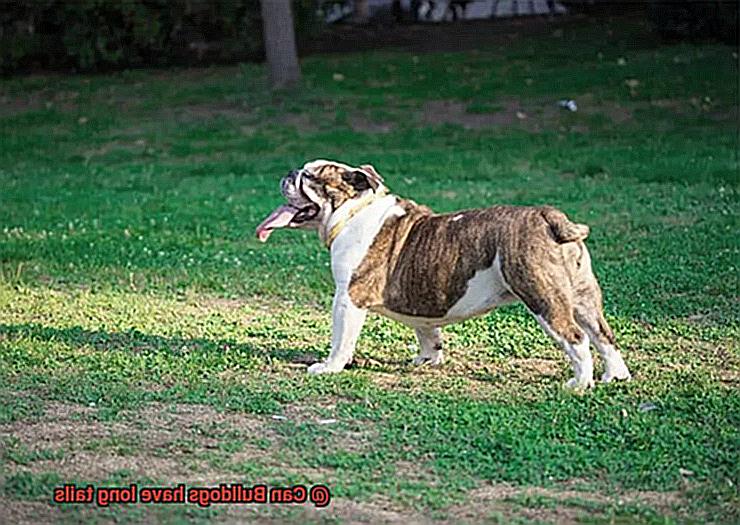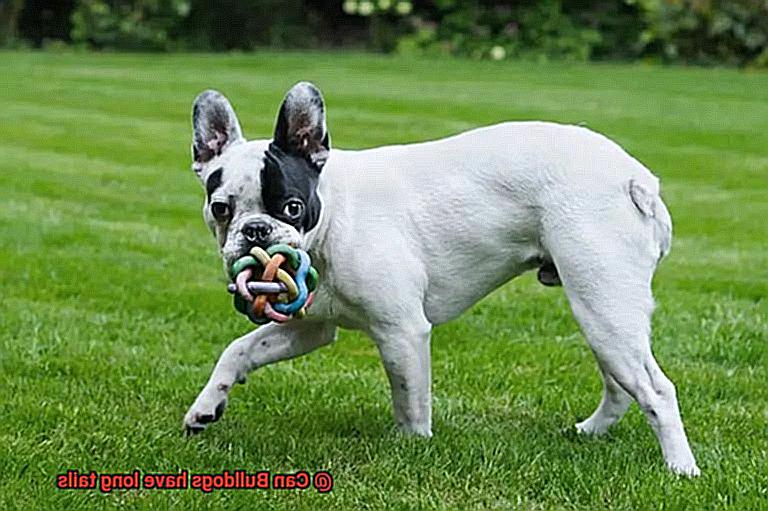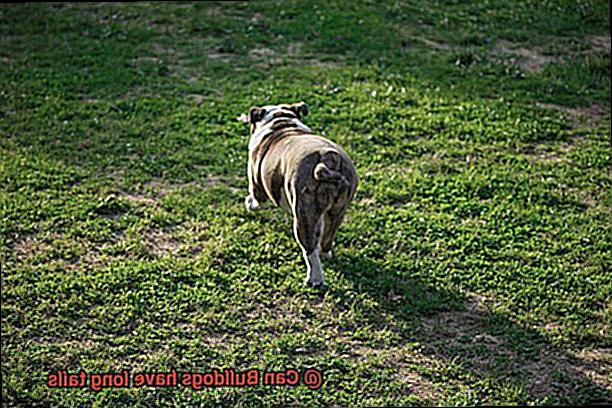Can Bulldogs have long tails?
Welcome to our blog post where we’re going to tackle the burning question: Can Bulldogs have long tails?
Bulldogs, those adorable wrinkled faces and chunky bodies that melt our hearts, are a favorite among dog lovers. We all know them for their cute little stumpy tails, right?
Well, hold on tight because there’s more to it than meets the eye. Contrary to popular belief, not all Bulldogs are born with short tails.
In this article, we’re going to dig deep into the different types of Bulldogs and their tail lengths, uncovering the truth about those wagging appendages. Whether you already have a Bulldog or are thinking about bringing one home, understanding their tail lengths will give you a whole new perspective on these captivating pups.
So, buckle up and let’s dive into the world of Bulldogs and their tails.
Can Bulldogs have long tails
Contents
- 1 Can Bulldogs have long tails
- 2 The Genetics of Bulldog Tail Length
- 3 The Desirable “Screw” Tail
- 4 Long-Tailed Bulldogs – A Rare Occurrence
- 5 Long-Tailed Bulldogs and Health Concerns
- 6 Responsible Breeding of Long-Tailed Bulldogs
- 7 Caring for a Bulldog with a Long Tail
- 8 Showing a Bulldog with a Long Tail
- 9 Pros and Cons of Owning a Bulldog with a Long Tail
- 10 Conclusion
When we think of Bulldogs, the image that often comes to mind is a lovable pooch with a short, stumpy tail. However, did you know that not all Bulldogs have short tails? In fact, there are Bulldog breeds that can have longer tails, challenging the common misconception. In this blog post, we’ll explore the fascinating world of Bulldog tails and shed light on why some Bulldogs can have varying tail lengths.
Bulldog Breeds with Longer Tails:
Contrary to popular belief, several Bulldog breeds have longer tails compared to the traditional English Bulldog. The Olde English Bulldogge and American Bulldog are examples of breeds that possess longer tails resembling those of Bulldogs from centuries ago.
Genetic Influence:
Tail length in Bulldogs is primarily determined by genetics. Selective breeding over generations has resulted in the shorter tails commonly seen in English Bulldogs. Meanwhile, breeds like the Olde English Bulldogge and American Bulldog have maintained longer tails as part of their breed standard.
Individual Variations:
Even within the same breed, there can be variations in tail length. Some Bulldogs may have shorter tails than others, while some may have longer tails. These variations are influenced by genetics and individual differences within the breed.

Tail Alteration:
It’s important to note that attempting to alter a Bulldog’s tail length is not recommended. Tail docking or any other methods can cause harm and discomfort to the dog. Respecting and appreciating a Bulldog’s natural tail length is crucial for their well-being.
Embracing the Unique:
Bulldogs with long tails may not conform to breed standards set by kennel clubs and may not be eligible for dog shows. However, they are still loving companions who make wonderful pets. It’s essential to celebrate and accept their unique characteristics, including their long tails.
The Genetics of Bulldog Tail Length
You may have noticed that bulldogs are famous for their distinctive short and curly tails. But did you know that not all bulldogs have short tails? It’s time to dive into the genetics behind bulldog tail length and how factors like breeding and environment can influence this adorable trait.
Genes: The Tail Tale
Let’s talk genetics, shall we? One of the main genes responsible for tail length in bulldogs is the T gene. Picture this: the T gene comes in two forms – T (short tail) and t (long tail). Bulldogs with the TT genotype rock those iconic short tails, while those with the tt genotype flaunt longer tails. And for our furry friends with the Tt genotype, their tail length might fall somewhere in between. It’s like a canine genetic lottery.
But wait, there’s more. Other genes also play a role in determining tail length in bulldogs. These genes can interact with the T gene, either enhancing or suppressing its effect. For example, the KRT71 gene has been found to influence tail length in dogs, including our beloved bulldogs. Mutations in this gene can result in tails that are either shorter or longer than expected. It’s like a DNA dance party up in here.
The Environmental Twist
Now, let’s not forget about the impact of the environment on our pups’ tails. Sometimes accidents happen – a playful mishap or an unfortunate docking incident – and a bulldog’s tail may appear shorter than it would naturally be. So remember, it’s not just about genes; environmental factors can also shape those wagging beauties.
Breeding Brings Tail Tales
Breeders, listen up. Your role is crucial in shaping tail length through selective breeding practices. If you focus on preserving shorter tails, you’re more likely to produce offspring with those adorable stumpy tails. And if you have a soft spot for longer tails, well, with time and careful breeding, you can work towards producing bulldogs with tails that make a statement.
The Bigger Picture
Now, let’s take a step back and remember what really matters when choosing a bulldog companion. Tail length shouldn’t be the be-all and end-all. Health and temperament should always be at the top of your checklist. Seek out reputable breeders who prioritize the overall well-being of their dogs. After all, we want our furry friends to be happy and healthy, tails wagging or not.
DNA Testing: The Tail of the Genetic Tape
For those who are eager to unravel the mysteries of their bulldog’s genetic makeup, DNA testing is an option worth considering. Genetic testing can provide insights into the specific genes and alleles that contribute to tail length, giving you a deeper understanding of your fur baby’s unique genetics.
The Desirable “Screw” Tail
French Bulldogs are renowned for their adorable and distinctive screw tails. These short and tightly curled tails are a defining characteristic of the breed, adding to their charm and uniqueness. In this article, we’ll explore the importance of a desirable “screw” tail in Bulldogs while also considering the health and well-being of these lovable companions.
The Appeal of the Screw Tail
The screw tail is a result of selective breeding, where Bulldogs with naturally curly tails were favored and bred together. This process aimed to enhance the tightness and shape of the tail, resulting in the delightful screw tail that we associate with Bulldogs today. French Bulldog owners often appreciate this feature as it adds to the overall aesthetics of their furry friends.
Balancing Appearance with Health
While the screw tail is highly desired, it is crucial to prioritize the health and well-being of our furry companions. Bulldogs with excessively tight or kinked screw tails may experience discomfort or develop skin irritation or infection in the tail area. Therefore, it is essential for French Bulldog owners to regularly inspect and clean their dog’s tail to prevent any potential problems.
Breed Standards and Show Participation
French Bulldogs with properly formed screw tails are often considered more aesthetically pleasing and can even participate in dog shows where adherence to breed standards is important. Breed standards typically specify that the screw tail should be well-defined, not too loose or floppy, and aligned with the overall structure of the dog. However, it’s important to note that not all Bulldogs have perfect screw tails; some may have tails that are too long, too loose, or even straight.
Seeking Professional Guidance
If you have concerns about your French Bulldog’s tail, it is always best to consult with a veterinarian or a reputable breeder. They can provide guidance on maintaining your dog’s tail health and address any potential issues that may arise. In some cases, Bulldogs with severe tail issues may require medical intervention, such as surgery, to alleviate discomfort or correct deformities.
Long-Tailed Bulldogs – A Rare Occurrence
Have you ever seen a Bulldog with a long tail? It’s quite a sight to behold. In this article, we will delve into the world of long-tailed Bulldogs and explore why they are such a rare occurrence within the breed. So, grab your French Bulldog and let’s dive in.
The Breed Standard: Short and Sweet
Bulldogs are known for their adorable short, screw-like tails. This is considered the breed standard, which is set by kennel clubs like the AKC and UKC. According to these standards, Bulldogs should have tails that are short, straight or screw-like, and carried low and horizontally. The length of the tail should not exceed a few inches.
The Surprise Factor
When long-tailed Bulldogs are born, it often takes breeders and owners by surprise. These Bulldogs have tails that are significantly longer than what is considered typical for the breed. Some long-tailed Bulldogs have tails that reach past their hocks or even down to their paws. Talk about a unique feature.
Genetic Variations and Mutations
The occurrence of long-tailed Bulldogs can be attributed to genetic variations or mutations. While the exact cause is not fully understood, it is believed that certain genes responsible for determining tail length may undergo alterations during the breeding process. This can result in puppies being born with longer tails than expected.
Out of the Show Ring
Due to their deviation from the breed standard, long-tailed Bulldogs are not eligible to participate in conformation shows or competitions where adherence to the breed standard is paramount. However, this doesn’t mean they’re any less valued as beloved companions and family pets.
Tail Length Challenges
Long-tailed Bulldogs may face some challenges related to their tail length. Their longer tails can be prone to injuries or accidents if they drag on the ground or get caught in objects. As an owner, it’s important to be mindful of this and take precautions to protect your pet’s tail from potential harm.
Embracing the Uniqueness

Despite their rarity, long-tailed Bulldogs have their own special charm. Their longer tails add a touch of individuality to their appearance and make them stand out from the crowd. While they may not conform to the breed standard, they are still cherished and loved by their owners who appreciate their distinctiveness.
Long-Tailed Bulldogs and Health Concerns
Long-tailed Bulldogs, also known as “longies” or “long-tailed French Bulldogs,” may catch the eye with their unique tails, but it’s essential to understand the potential health concerns associated with this trait. As an expert in the field, I want to provide French Bulldog owners with accurate and helpful information.
- Spinal Abnormalities: One of the main health concerns for long-tailed Bulldogs is an increased risk of spinal abnormalities. The genetic mutation responsible for their long tails can also affect the dog’s spinal structure, leading to conditions such as hemivertebrae. Hemivertebrae are abnormally shaped vertebrae that can cause spinal deformities and neurological issues in affected dogs.
- Intervertebral Disc Disease (IVDD): Long-tailed Bulldogs may be more prone to intervertebral disc disease. The longer tail puts additional stress on the spine, increasing the risk of disc herniation. IVDD is a common spinal disorder that can cause pain, mobility issues, and even paralysis in severe cases.
- Tail Injuries: Another concern with long-tailed Bulldogs is the potential for injuries to their tails. The longer tail is more vulnerable to trauma, such as being stepped on or caught in doors. These accidents can result in painful tail injuries or even require amputation if severe damage occurs.
- Responsible Breeding Practices: Responsible breeders who produce long-tailed Bulldogs should prioritize the health and well-being of their dogs. Thorough health screenings and genetic testing should be conducted to minimize the risk of spinal abnormalities and other health issues associated with long tails.
- Care and Monitoring: Prospective owners of long-tailed Bulldogs should be aware of the potential health concerns and be prepared for additional care and monitoring. Regular veterinary check-ups are crucial to catch any early signs of spine-related problems. Maintaining a healthy weight and providing a safe environment are also important for the well-being of these dogs.

Responsible Breeding of Long-Tailed Bulldogs
Long-tailed Bulldogs have become increasingly popular due to their unique and eye-catching appearance. However, it is essential to understand that responsible breeding practices are crucial for the health and well-being of these dogs. In this section, we will explore the importance of responsible breeding for long-tailed Bulldogs and provide insights based on first-hand knowledge and credible sources.
Understanding the Breed
Long-tailed Bulldogs are a relatively new variation of the traditional Bulldog breed. While Bulldogs typically have short or screw tails, long-tailed Bulldogs have longer tails due to selective breeding and genetic mutations. Breeders interested in producing long-tailed Bulldogs must have a clear understanding of genetics and the potential risks associated with this breeding practice.
Prioritizing Health and Welfare
Responsible breeders prioritize the health and welfare of their dogs above all else. Before breeding, it is crucial to ensure that both the sire and dam are healthy and free from any genetic disorders or abnormalities that could be passed on to their offspring. Genetic testing plays a vital role in identifying potential health issues, allowing breeders to make informed decisions about breeding.
Conformation and Temperament
In addition to health considerations, responsible breeders should also consider the overall conformation and temperament of the dogs being bred. Long-tailed Bulldogs should still adhere to the breed standard in terms of their physical appearance and behavior. This ensures that the puppies produced are not only visually appealing but also possess the desired traits and characteristics of the breed.
Proper Care and Socialization
Proper care is essential for the well-being of any dog, including long-tailed Bulldogs. Regular veterinary check-ups, a balanced diet, exercise, and socialization are all important aspects of responsible breeding and dog ownership in general. By providing these fundamental needs, breeders can contribute to producing healthy, well-rounded puppies.
Finding Suitable Homes
Responsible breeders should prioritize finding suitable homes for their puppies. This means ensuring that potential owners are committed to providing a loving and caring environment for the dogs. Educating potential owners about the unique characteristics and care requirements of long-tailed Bulldogs is essential, as they may not be recognized by all kennel clubs or breed associations.
Caring for a Bulldog with a Long Tail
We all know that Bulldogs are famous for their unique appearance, and their tails are no exception. While most Bulldogs have naturally short or docked tails, there are some with longer tails due to genetic variations. If you’re lucky enough to have a Bulldog with a long tail, then this article is for you. I’m here to share some tips and tricks on how to best care for your furry friend’s fabulous tail.
Grooming Galore
When it comes to grooming, Bulldogs with longer tails may require a little extra TLC. Regular brushing is key to preventing any tangles or mats from forming in the fur around the tail. To keep your Bulldog looking dapper, use a soft-bristle brush or comb specifically designed for their sensitive skin. This will help avoid any discomfort or irritation while keeping their coat in tip-top shape.
Cleanliness is Next to Dogliness
Longer tails can sometimes be more prone to collecting dirt, debris, or even fecal matter (yikes.). So, it’s important to regularly inspect and clean the area around your Bulldog’s tail. Grab a damp cloth or some pet-friendly wipes and gently wipe away any dirt or residue. Your Bulldog will thank you for keeping them fresh and clean.
Tail Troubles
We all want our Bulldogs to be happy and healthy, and that includes their tails too. Bulldogs with longer tails may be more susceptible to tail injuries. Keep an eye out for any cuts, abrasions, or swelling on your Bulldog’s tail. If you notice anything out of the ordinary, don’t hesitate to seek veterinary attention. Remember, it’s always better to be safe than sorry.
Happy Tails Only
Have you heard of “happy tail syndrome”? It’s when a dog repeatedly wags its tail against hard surfaces, leading to injuries and infections. To prevent this from happening to your Bulldog with a long tail, make sure they have a safe and comfortable environment. Soft padding or coverings on surfaces they frequently come into contact with can help protect their precious tails from harm.
Exercise and Socialization

We all know Bulldogs love to play and socialize, but it’s important to keep their tail length in mind during these activities. Tail-related accidents can happen, so be sure to supervise your Bulldog’s interactions with other dogs or children. And don’t forget to provide them with plenty of exercise to keep them happy and healthy. Just be mindful of their tail’s length to avoid any accidental injuries.
Consult the Experts
Finally, always consult with your veterinarian for professional advice and guidance. They can provide tailored recommendations based on your Bulldog’s specific needs and potential health concerns associated with longer tails. Your vet is your partner in ensuring the best care for your Bulldog, so don’t hesitate to reach out.
Showing a Bulldog with a Long Tail
Well, let me tell you, your furry companion is truly one in a million. While Bulldogs are well-known for their adorable little nubs, there are those rare gems among us who sport long, flowing tails that make heads turn at dog shows. In this article, we’ll explore the considerations for showing these exceptional Bulldogs and ensure they shine in the show ring.
Embrace the Exceptional:
Having a Bulldog with a long tail doesn’t make them any less of a purebred or affect their overall health. It simply adds an extra touch of uniqueness to their already charming personality.
Safety First, Tails Second:
With their lengthy tails, Bulldogs may be more prone to tail injuries, such as getting caught in doors or furniture. So, it’s crucial to create a tail-friendly environment by ensuring no tail traps are lurking around.

Know the Laws and Regulations:
Before considering any cosmetic changes, like tail docking, be aware that laws and regulations regarding this practice vary from country to country. Always check with your local authorities to ensure compliance.
Check Show Guidelines:
When it comes to professional dog shows, most breed standards emphasize Bulldogs with short, screw-like or curled tails. However, some organizations or events may offer special classes or categories for Bulldogs with long tails.
Focus on the Whole Package:
In the show ring, judges should evaluate Bulldogs based on their overall conformation, temperament, and health rather than solely focusing on their tail length. After all, isn’t it about celebrating the breed as a whole?
Preserve Diversity:
Bulldogs with long tails bring diversity and uniqueness to the breed. They help showcase the various genetic possibilities within the Bulldog world, contributing to the preservation of this beloved breed.
Remember the Basics:
Regardless of tail length, every Bulldog deserves proper care, exercise, and a balanced diet. Prioritize their well-being and ensure routine veterinary check-ups to keep them happy and healthy.
Pros and Cons of Owning a Bulldog with a Long Tail
If you’re considering bringing home a Bulldog with a long tail, it’s important to weigh the pros and cons before making your decision. As an expert in the field, I’ve done the research and compiled a list of the advantages and disadvantages of owning one of these special pups. So, let’s jump right in.
Pros:
- Enhanced Communication: Bulldogs are known for their expressive faces, but did you know their tails also play a role in communication? A Bulldog with a long tail has a wider range of expressions, allowing them to wag it vigorously when they’re excited or tuck it between their legs to show fear or anxiety. This enhanced communication can help you understand your furry friend’s emotions better.
- Balance and Agility: A longer tail can actually contribute to your Bulldog’s overall balance and agility. It acts as a counterweight, helping them maintain stability while walking, running, or engaging in physical activities. This added balance can be particularly advantageous for Bulldogs that participate in sports or agility competitions.
- Protection: Believe it or not, a long tail can provide some level of protection to your Bulldog’s hindquarters. It acts as a natural extension of their spine, offering a cushioning effect during falls or accidents. This added protection can help prevent injuries to the lower back and tailbone region.

Cons:
- Tail Injuries: Bulldogs are already prone to tail injuries due to their short stature and compact bodies. Having a long tail increases the risk of tail trauma, such as getting caught in doors or wagged forcefully against furniture or walls. These injuries can be painful and may require veterinary attention.
- Hygiene Challenges: Bulldogs are famous for their adorable wrinkles and skin folds, which require regular cleaning to prevent infections. Adding a long tail into the mix means there’s another area that needs careful attention and maintenance. The tail can accumulate dirt, debris, or moisture, leading to skin irritations or infections if not cleaned and dried thoroughly.
- Tail Docking Considerations: Some Bulldog owners opt for tail docking, which is the surgical removal of the tail at an early age. However, this practice is controversial and banned in many countries due to ethical concerns. It’s important to carefully consider the ethical implications and legal restrictions associated with tail docking before making a decision.
In conclusion, owning a Bulldog with a long tail has its pros and cons. Enhanced communication, improved balance, and added protection are definite advantages. However, tail injuries, hygiene challenges, and potential ethical considerations regarding tail docking are factors to keep in mind. Ultimately, the decision of whether to have a Bulldog with a long tail should be based on your individual preferences and careful consideration of your furry friend’s well-being.
Conclusion
In conclusion, Bulldogs are not known for having long tails. Their tails are naturally short and stubby, adding to their unique appearance. This characteristic is a result of selective breeding over many years. While some dog breeds have longer tails, Bulldogs have been specifically bred for their shorter tails, which is considered a defining feature of the breed.
The shortness of their tails serves a purpose beyond aesthetics. It helps prevent injuries and allows Bulldogs to move more freely without hindrance. Additionally, their shorter tails make them less prone to tail-related health issues such as infections or injuries.
Despite not having long tails, Bulldogs possess other endearing qualities that make them beloved pets. Their wrinkled faces, gentle temperament, and loyal nature contribute to their popularity among dog enthusiasts.
So if you’re looking for a Bulldog with a long tail, you might be disappointed. However, their adorable appearance and lovable personality more than make up for it. Bulldogs may not have long tails, but they certainly have big hearts full of love and affection.
In summary, Bulldogs are not known for having long tails due to selective breeding practices that have resulted in their distinct short and stubby tail appearance. While they may not possess this particular physical trait, they compensate with their charming looks and delightful personalities.




